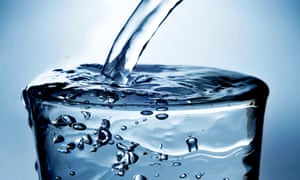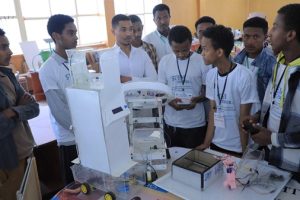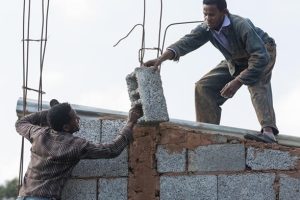
Documents indicate that potable water coverage in Ethiopia is increasing from time to time with due government investment. According to 2015/16 Ethiopia yearbook prepared by the former Government Communication Affaires Office of Ethiopia, the total water coverage of the country out of the capital was 61 percent where the coverage in Addis Ababa exceeds over 90 percent.
Clear potable water coverage of the country is showing fast increment especially after the First Growth and Transformation Plan (GTP-I) following the government special attention to the sector.
Parallel with the expansion and distribution of potable water from improved sources, the safety of water is a serious issue to protect it from any contamination on the process from its supply to the household level. Affecting by many factors especially expansion of factories, chemicals, lack of proper management of wastage in towns, expansion of fertilizer and other chemicals in rural areas and fractures caused on water pipelines leads for tap water contamination.
Considering these factors and its side effect on public health, countries are implementing different sophisticated modern technologies to control contamination. Researcher within Environmental Public Health
Research Team at Ethiopian Public Health Institute, Sisay Derso told The Ethiopian Herald that currently the water treatment system has attained a level of applying Nano technology in developed countries.
Cited DHS (Demographic Health Survey) research held in 2016 in Ethiopia, the country’s improved water coverage varies from urban and rural. According to the research, 97 percent of households in Ethiopian cities and towns got potable water from improved sources, according to Sisay.
He noted that improved sources are defined as protected and safe from contaminations by controlling the exposing factors for water pollution from the source and its distribution through pipelines to tap water with filtration mechanisms. Based on this criterion Ethiopian cities and towns improved water coverage is 97 percent and the rural part of the country is 57 percent, he noted.
Although this indicates that the treatment mechanism of tap water source is improved, the water transmission pipelines are affected by many factors and exposing for contamination especially in towns. Due to damages, long time service, lack of continuous checking and evaluation mechanisms, the process of water transmission exposes for pollution which lead for color, taste, physical and chemical changes. Phosphate and sulfate chemicals can affect the water in its process of transportation, Sisay said.
In addition micro biological contamination may also happen due to environmental effects. So to control water from any pollution, it needs modern treatment mechanisms, continuous follow-up and evaluation and modern technological systems, the researcher noted.
For him, the main causes, which affects water pipelines for contamination and damage is lack of operational maintenance after networking the system. To prevent water sources contamination and to strengthen the safety of improved sources from contamination, it needs continues follow-up and maintenance the transmitting lines
Generally, in Ethiopia, water treatment is not well developed and even the treatment level is conventional treatment mechanism. Only few towns and cities are using water treatment and mostly Addis Ababa. Yet the treatment mechanism is not sophisticated to control all microorganisms.
As to the researcher, when we think the area which the water pipelines are passed through, there are many pollutant factors like chemicals and other microorganisms which the current treatments cannot prevent from. Even in the process, the water can lost its natural content. To treat such like water pollutants, it needs further sophisticated technologies.
Not only modern treatments, the country have not any mechanism or material to evaluate the percentage of water reached for use and the lost on process. Parallel with its expansion and distribution of potable drinking water, the country should focus for proper usage of the supplied one. For proper usage of the produced water, the percentage of used and lost water should be identified.
Continues monitoring and evaluation mechanism by properly implementing the climate resilient water safety plan project is one mechanism. The project was designed to monitor and checkup the process of water from its source, production process, transmission and point of use on the clients/users. This plan needs stakeholders’ engagement, protecting quality of water products, so although sophisticated technology is not in use, if you processed the water from the source, it can minimize the pollution. This plan has started in some parties of the country since 2016, Sisay stated.
Beyond that introducing modern treatment systems and controlling mechanisms through GIS and other software systems is necessary as urbanization, industrialization and other push factors for pollution are growing fats. Interconnecting modern systems to report contamination problems and water lost communicating with the center is necessary for the future. As our controlling mechanism is end pipeline testing, he added.
A new smart water meter system is innovated by Ethiopian entrepreneurs which gained patent right recently. The new water meter a modern technological system to report the used water without person visit to the center, report water contaminations and reporting the amount of lost water. It also offer accurate measurements of consumption without personal reader and transmits the data wireless on network and customer management center, Smart Water Meters Project Manager of the innovator ‘dVenture’ company.
It detects leakage, reverse flow, tampering and transmit a data every hour to central data management office and the client using smart communication systems connecting with software.
Sisay stated that, although I did not know the function and the general system of the new innovated technological product, introducing such like modern systems is relevant and timely. Yet, it needs serious evaluation taste for functioning and needs modern networking software systems at the center.
Such like new technological innovations are necessary to evaluate the proper water usage and water contamination. To implement such materials, the applicability of the material should be seriously measured practically. In addition, the total system of the water from its center should be digitalized, the researcher said.
The Ethiopian Herald March 23/2019
BY DARGIE KAHSAY





